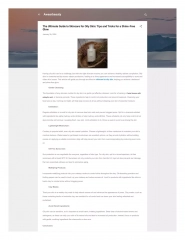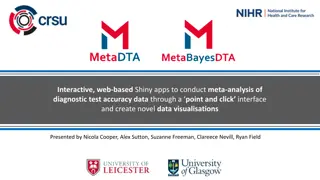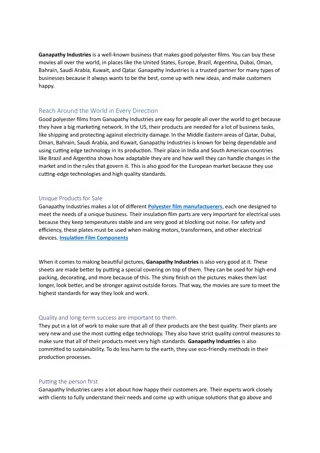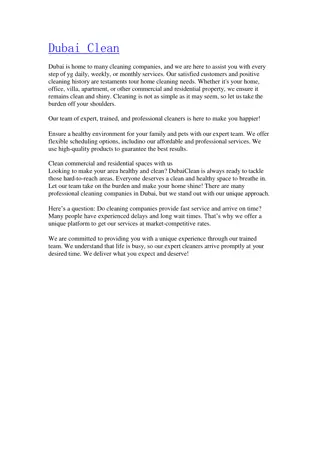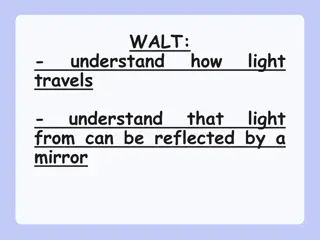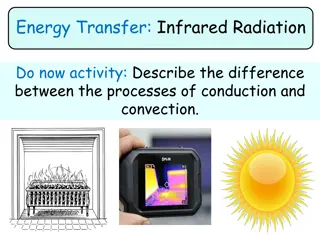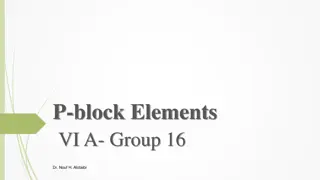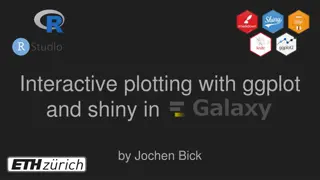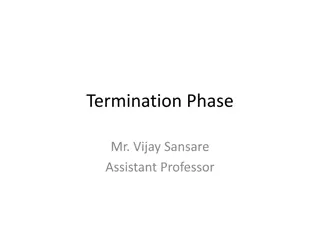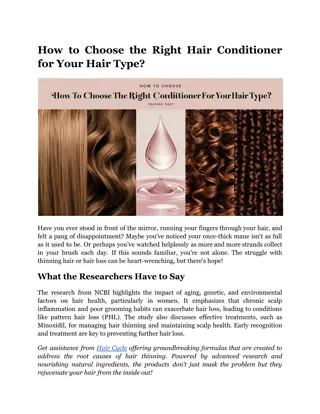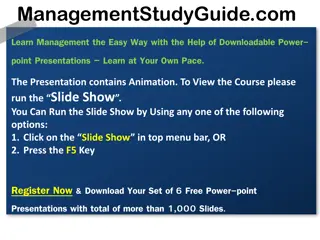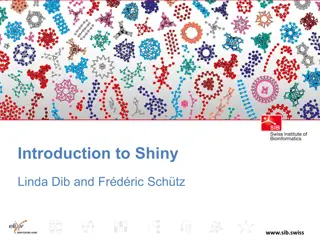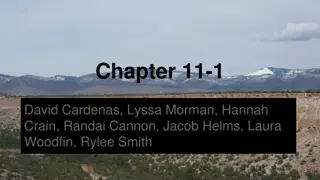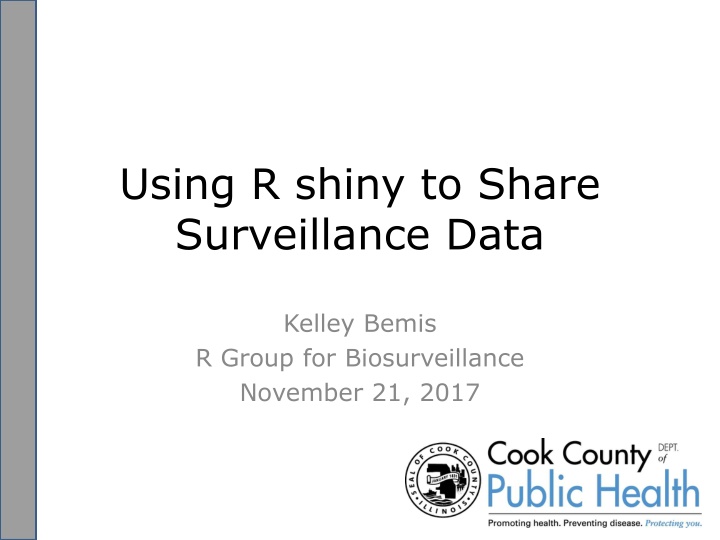
Using R Shiny for Surveillance Data Sharing
Explore how the Cook County Department of Public Health leverages R Shiny to share seasonal influenza surveillance data, enhancing situational awareness, decision-making, and response strategies. Discover the benefits, limitations, and applications of this innovative approach in public health surveillance.
Uploaded on | 0 Views
Download Presentation

Please find below an Image/Link to download the presentation.
The content on the website is provided AS IS for your information and personal use only. It may not be sold, licensed, or shared on other websites without obtaining consent from the author. If you encounter any issues during the download, it is possible that the publisher has removed the file from their server.
You are allowed to download the files provided on this website for personal or commercial use, subject to the condition that they are used lawfully. All files are the property of their respective owners.
The content on the website is provided AS IS for your information and personal use only. It may not be sold, licensed, or shared on other websites without obtaining consent from the author.
E N D
Presentation Transcript
Using R shiny to Share Surveillance Data Kelley Bemis R Group for Biosurveillance November 21, 2017
Agenda 1. Why we re using a shiny app 2. How we built the shiny app 3. Code Cook County Department of Public Health
Seasonal Influenza Surveillance Monitor influenza activity year round Produce weekly surveillance reports from October (Week 40) to May (Week 20) Disseminated to hospitals, long-term care facilities, laboratories, schools, etc. Cook County Department of Public Health
Uses for Surveillance Data Situational awareness Ordering supplies (test kits, etc.) Prescribing antivirals Increased public messaging and signage Implementing temporary visitor restrictions Cook County Department of Public Health
Traditional Reporting Create a picture from several data sources, including: Emergency room visits % of ED visits for ILI Sentinel laboratories % of specimens positive for flu ICU hospitalizations # of cases associated with flu Mortality data % of deaths associated with flu Cook County Department of Public Health
Traditional Reporting Data stored in excel spreadsheets Excel graphs pasted into a Word document Saved as a PDF and emailed to our flu listserv on Fridays Posted on CCDPH website Cook County Department of Public Health
Limitations Graphs are small, difficult to see exact data points Limited in the amount of historical data displayed Cannot customize or extract data Difficult to access online No room for spatial data Cook County Department of Public Health
Solution Create an online application! But how ? Cook County Department of Public Health
shiny Steps In Started learning R in January Started shiny tutorials in late July App deployed on October 13th Emailed to flu listserv (~180 people) Posted link on CCDPH website Cook County Department of Public Health
Feedback so far Google analytics: 179 sessions from 105 unique people (as of 11/20/17) In person meeting with ~30 infection preventionists and LTCF staff: all reported they have used or will use the app this flu season Cook County Department of Public Health
A Quick Tour https://ccdphcd.shinyapps.io/weekly_influenza_su rveillance_beta/ Cook County Department of Public Health
So you want to build a shiny app... Cook County Department of Public Health
Step 1: Get inspired See examples of complete apps and shiny widgets at https://shiny.rstudio.com/gallery/ Watch the shiny video tutorials at https://shiny.rstudio.com/tutorial/ Watch the Feb. 26th, 2015 R Group webinar: How to Develop a Simple Shiny App at https://sites.google.com/site/rapplicationforbios urveillance/home/meetings Cook County Department of Public Health
Step 2: Draft the vision Know the end goal Get a sense of what widgets and layouts you ll need Cook County Department of Public Health
Step 3: Break it down into one piece Start with just one user control and one output (e.g. a plot) Cook County Department of Public Health
shiny: A Brief Refresher shiny apps consist of two functions 1. a ui function (for user interface) that creates the layout of the application and the user controls 2. a server function that creates the content based on the user s selections Cook County Department of Public Health
inputId and outputId The ui and server functions talk to each other to create an interactive app The ui function collects user-selected values though the inputId variable and sends that information to the server function The server function uses the inputId to create content that is fed back to the ui function for display The content is tagged with an outputId variable so the ui function knows where to display it Cook County Department of Public Health
inputId and outputId 1. User chooses what regions to display Cook County Department of Public Health
inputId and outputId 2. Choices are stored in input$regionpick Cook County Department of Public Health
inputId and outputId 3. Filtered data set is created using inputID Cook County Department of Public Health
inputId and outputId 4. Filtered data set is sent to a render* function to create content Cook County Department of Public Health
inputId and outputId 5. Rendered plot is stored in object with the outputId regionplot Cook County Department of Public Health
inputId and outputId 6. Rendered regionplot plot is sent to the designated space for it on the ui Cook County Department of Public Health
inputId and outputId 6. Rendered regionplot plot is sent to the designated space for it on the ui Cook County Department of Public Health
inputId and outputId Image Credit: National Socio-Environmental Synthesis Center https://sesync-ci.github.io/basic-Shiny-lesson/ Cook County Department of Public Health
Step 4: Build iteratively Use your working mini-app as a recipe to create additional plots or features Build a more advanced user interface with shiny s pre-built lay-outs sidebarLayout navbarPage Test continuously!!! Comment extensively Cook County Department of Public Health
Step 5: Customize the ui with HTML/CSS shiny functions that build your user interface are creating HTML code under the hood Tweaking or adding HTML/CSS content can customize the look of your app Change the relative size of panels Add additional elements (e.g. headers, paragraphs, links to other content) Change colors, fonts, and spacing Cook County Department of Public Health
Step 5: Customize the ui with HTML/CSS Tweaking lay-outs: Utilize the fluid shiny grid system Rows sub-divided into 12 columns Based on popular HTML framework called Bootstrap fluidRow() fluidRow() column(1, ) column(4, ) fluidRow() column(4, ) column(4, ) fluidRow() column(6, ) column(6, ) column(width = x) where x is between 1 and 12 Cook County Department of Public Health
Step 5: Customize the ui with HTML/CSS Adding elements: HTML elements are building blocks used to create webpages Elements are surrounded by tags <p>I will become a paragraph.</p> <h1>I will become a large header.</h1> shiny has 110 functions, called tags functions, that create HTML elements tags$p( I will become a paragraph. ) tags$h1( I will become a large header. ) The most common tags functions have helper functions where you can drop the tags$ part p( I will become a paragraph. ) h1( I will become a large header. ) Cook County Department of Public Health
Step 5: Customize the ui with HTML/CSS Cook County Department of Public Health
Step 5: Customize the ui with HTML/CSS Resources for learning HTML/CSS FreeCodeCamp: www.freecodecamp.org Learn to Code HTML & CSS: https://learn.shayhowe.com/html-css/ Applying HTML/CSS to your shiny apps Understanding the shiny grid system: https://shiny.rstudio.com/articles/layout-guide.html Customizing your ui with HTML and CSS: https://shiny.rstudio.com/articles/html-tags.html; https://shiny.rstudio.com/articles/css.html shiny tags$ glossary: https://shiny.rstudio.com/articles/tag-glossary.html Cook County Department of Public Health
Step 6: Share your app Two options: 1)Download shiny server and host it yourself 2)Use R Studio s hosting service: shinyapps.io Hosting on shinyapps.io Free plan with <25 active hours per month Publish from within Rstudio Upload your data along with your code Cook County Department of Public Health
Final Thoughts Borrow code liberally and Google often Test by both running locally AND publishing Don t let the perfect be the enemy of the good Cook County Department of Public Health
Contact Information https://github.com/kb230557/Flu_Shiny_App Kelley Bemis Epidemiologist IV Communicable Disease 708-836-8666 kbemis@cookcountyhhs.org Cook County Department of Public Health

